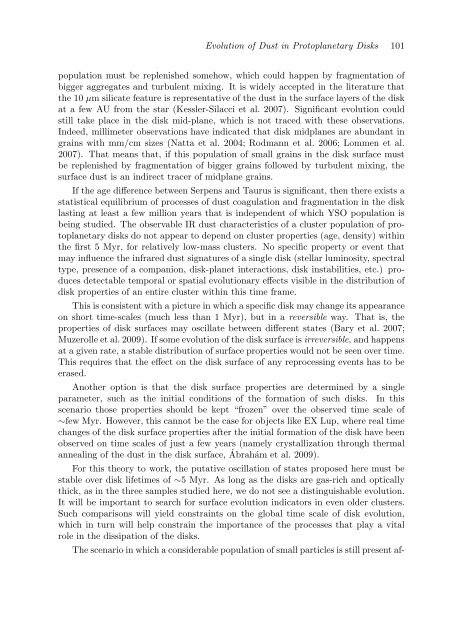Observational Constraints on The Evolution of Dust in ...
Observational Constraints on The Evolution of Dust in ...
Observational Constraints on The Evolution of Dust in ...
You also want an ePaper? Increase the reach of your titles
YUMPU automatically turns print PDFs into web optimized ePapers that Google loves.
Evoluti<strong>on</strong> <strong>of</strong> <strong>Dust</strong> <strong>in</strong> Protoplanetary Disks 101<br />
populati<strong>on</strong> must be replenished somehow, which could happen by fragmentati<strong>on</strong> <strong>of</strong><br />
bigger aggregates and turbulent mix<strong>in</strong>g. It is widely accepted <strong>in</strong> the literature that<br />
the 10 µm silicate feature is representative <strong>of</strong> the dust <strong>in</strong> the surface layers <strong>of</strong> the disk<br />
at a few AU from the star (Kessler-Silacci et al. 2007). Significant evoluti<strong>on</strong> could<br />
still take place <strong>in</strong> the disk mid-plane, which is not traced with these observati<strong>on</strong>s.<br />
Indeed, millimeter observati<strong>on</strong>s have <strong>in</strong>dicated that disk midplanes are abundant <strong>in</strong><br />
gra<strong>in</strong>s with mm/cm sizes (Natta et al. 2004; Rodmann et al. 2006; Lommen et al.<br />
2007). That means that, if this populati<strong>on</strong> <strong>of</strong> small gra<strong>in</strong>s <strong>in</strong> the disk surface must<br />
be replenished by fragmentati<strong>on</strong> <strong>of</strong> bigger gra<strong>in</strong>s followed by turbulent mix<strong>in</strong>g, the<br />
surface dust is an <strong>in</strong>direct tracer <strong>of</strong> midplane gra<strong>in</strong>s.<br />
If the age difference between Serpens and Taurus is significant, then there exists a<br />
statistical equilibrium <strong>of</strong> processes <strong>of</strong> dust coagulati<strong>on</strong> and fragmentati<strong>on</strong> <strong>in</strong> the disk<br />
last<strong>in</strong>g at least a few milli<strong>on</strong> years that is <strong>in</strong>dependent <strong>of</strong> which YSO populati<strong>on</strong> is<br />
be<strong>in</strong>g studied. <strong>The</strong> observable IR dust characteristics <strong>of</strong> a cluster populati<strong>on</strong> <strong>of</strong> protoplanetary<br />
disks do not appear to depend <strong>on</strong> cluster properties (age, density) with<strong>in</strong><br />
the first 5 Myr, for relatively low-mass clusters. No specific property or event that<br />
may <strong>in</strong>fluence the <strong>in</strong>frared dust signatures <strong>of</strong> a s<strong>in</strong>gle disk (stellar lum<strong>in</strong>osity, spectral<br />
type, presence <strong>of</strong> a compani<strong>on</strong>, disk-planet <strong>in</strong>teracti<strong>on</strong>s, disk <strong>in</strong>stabilities, etc.) produces<br />
detectable temporal or spatial evoluti<strong>on</strong>ary effects visible <strong>in</strong> the distributi<strong>on</strong> <strong>of</strong><br />
disk properties <strong>of</strong> an entire cluster with<strong>in</strong> this time frame.<br />
This is c<strong>on</strong>sistent with a picture <strong>in</strong> which a specific disk may change its appearance<br />
<strong>on</strong> short time-scales (much less than 1 Myr), but <strong>in</strong> a reversible way. That is, the<br />
properties <strong>of</strong> disk surfaces may oscillate between different states (Bary et al. 2007;<br />
Muzerolle et al. 2009). If some evoluti<strong>on</strong> <strong>of</strong> the disk surface is irreversible, and happens<br />
at a given rate, a stable distributi<strong>on</strong> <strong>of</strong> surface properties would not be seen over time.<br />
This requires that the effect <strong>on</strong> the disk surface <strong>of</strong> any reprocess<strong>in</strong>g events has to be<br />
erased.<br />
Another opti<strong>on</strong> is that the disk surface properties are determ<strong>in</strong>ed by a s<strong>in</strong>gle<br />
parameter, such as the <strong>in</strong>itial c<strong>on</strong>diti<strong>on</strong>s <strong>of</strong> the formati<strong>on</strong> <strong>of</strong> such disks. In this<br />
scenario those properties should be kept “frozen” over the observed time scale <strong>of</strong><br />
∼few Myr. However, this cannot be the case for objects like EX Lup, where real time<br />
changes <strong>of</strong> the disk surface properties after the <strong>in</strong>itial formati<strong>on</strong> <strong>of</strong> the disk have been<br />
observed <strong>on</strong> time scales <strong>of</strong> just a few years (namely crystallizati<strong>on</strong> through thermal<br />
anneal<strong>in</strong>g <strong>of</strong> the dust <strong>in</strong> the disk surface, Ábrahám et al. 2009).<br />
For this theory to work, the putative oscillati<strong>on</strong> <strong>of</strong> states proposed here must be<br />
stable over disk lifetimes <strong>of</strong> ∼5 Myr. As l<strong>on</strong>g as the disks are gas-rich and optically<br />
thick, as <strong>in</strong> the three samples studied here, we do not see a dist<strong>in</strong>guishable evoluti<strong>on</strong>.<br />
It will be important to search for surface evoluti<strong>on</strong> <strong>in</strong>dicators <strong>in</strong> even older clusters.<br />
Such comparis<strong>on</strong>s will yield c<strong>on</strong>stra<strong>in</strong>ts <strong>on</strong> the global time scale <strong>of</strong> disk evoluti<strong>on</strong>,<br />
which <strong>in</strong> turn will help c<strong>on</strong>stra<strong>in</strong> the importance <strong>of</strong> the processes that play a vital<br />
role <strong>in</strong> the dissipati<strong>on</strong> <strong>of</strong> the disks.<br />
<strong>The</strong> scenario <strong>in</strong> which a c<strong>on</strong>siderable populati<strong>on</strong> <strong>of</strong> small particles is still present af-
















